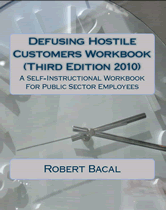
A Quick Guide To Employee Orientation - Help For Managers & HR
Here's a short article to help both managers and human resource professionals think a bit more about employee orientation, why it is so important to both employee retention and productivity, and how to go about it.
We would not be understating the case if we said that orienting employees to their workplaces and their jobs is one of the most neglected functions in government. Countless horror stories exist about how a new employee has received a ten minute talk with the manager, and directed to his or her office position, with no further guidance or instruction. Not only is this exceedingly stressful for the employee, but it virtually guarantees a very long period of unproductiveness for the employee.
In this month's PSM Supplement we present an overview of the orientation process, and a checklist that you can use when orienting new staff. As you read the article, keep in mind that orientation is also important for existing employees if a) they have never received proper orientation or b) there have been many changes in the organization and it's purpose and function.
Purposes of Orientation
Orientation isn't a nicety! It is used for the following purposes:
1. To Reduce Startup-Costs
Proper orientation can help the employee get "up to speed" much more quickly, thereby reducing the costs associated with learning the job.
2. To Reduce Anxiety
Any employee, when put into a new, strange situation, will experience anxiety that can impede his or her ability to learn to do the job. Proper orientation helps to reduce anxiety that results from entering into an unknown situation, and helps provide guidelines for behaviour and conduct, so the employee doesn't have to experience the stress of guessing.
3. To Reduce Employee Turnover
Employee turnover increases as employees feel they are not valued, or are put in positions where they can't possibly do their jobs. Orientation shows that the organization values the employee, and help provide tools necessary for succeeding in the job.
4. To Save Time For Supervisor & Co-Workers
Simply put, the better the initial orientation, the less likely supervisors and co-workers will have to spend time teaching the employee.
5. To Develop Realistic Job Expectations, Positive Attitudes and Job Satisfaction
It is important that employees learn early on what is expected of them, and what to expect from others, in addition to learning about the values and attitudes of the organization. While people can learn from experience, they will make many mistakes that are unnecessary and potentially damaging.
Two Kinds of Orientation
There are two related kinds of orientation. The first we will call Overview Orientation, and deals with the basic information an employee will need to understand the broader system he or she works in. Overview Orientation includes helping employees understand:
- government in general, the department and the branch
- important policies and general procedures (non-job specific)
- information about compensation and benefits
- safety and accident prevention issues
- employee and union issues (rights, responsibilities)
- physical facilities
Often, Overview Orientation can be conducted by the personnel department with a little help from the branch manager or immediate supervisor, since much of the content is generic in nature.
The second kind of orientation is called Job-Specific Orientation, and is the process that is used to help employees understand:
- function of the organization, and how the employee fits in
- job responsibilities, expectations, and duties
- policies, procedures, rules and regulations
- layout of workplace
- introduction to co-workers and other people in the broader organization.
Job specific orientation is best conducted by the immediate supervisor, and/or manager, since much of the content will be specific to the individual. Often the orientation process will be ongoing, with supervisors and co-workers supplying coaching.
Some Tips
1. Orientation should begin with the most important information (basic job survival).
2. Orientation should emphasize people as well as procedures and things. Employees should have a chance to get to know people and their approaches and styles in both social and work settings.
3. Buddy an employee to a more experienced person, but make sure the more experienced person wants to buddy up, and has the inter-personal skills. This provides ongoing support.
4. Introduce employees to both information and people in a controlled way. A new employee can't absorb everything at once, so don't waste your time. Space out introductions.
Conclusion
Orientation (or lack of it) will make a significant difference in how quickly an employee can become more productive, and also has long term effects for the organization. To help you in the orientation process, we have included a checklist for the Job-Specific Orientation. Note that any complete program will include other elements...those that would be included in the Overview Orientation.





